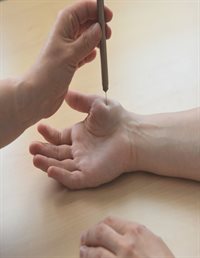Quantitative Sensory Testing

Quantitative Sensory Testing (QST) is a systematic and objective method used in clinical and research settings to assess an individual's sensory perception and quantify their responses to various sensory stimuli. It involves the precise measurement of sensory thresholds, which are the minimum levels of stimulation required for a person to detect or discriminate different sensory modalities, such as touch temperature, and pressure.
QST employs controlled and standardised sensory stimuli, including thermal (heat and cold), mechanical (pressure and vibration), and electrical stimuli. These stimuli are applied to specific anatomical sites to assess sensory function in different regions of the body. Applications involve specialised devices and instruments (algometer, punctate stimulator, pressure cuff, thermal probe), which are used to deliver and control the sensory stimuli, ensuring accuracy and consistency in the testing process.
QST measures various sensory parameters, including detection thresholds (the lowest level of stimulus intensity that an individual can perceive), pain thresholds (the point at which a sensory stimulus becomes painful or uncomfortable), tactile thresholds (the ability to discriminate between different levels of pressure, temperature or vibration), and temporal parameters (assessing the duration and adaptation of sensory perceptions). It employs quantifiable measurement units, such as pressure in kilopascals (kPa), temperature in degrees Celsius, pressure in millimetres of mercury (mmHg), or vibration frequency in hertz (Hz), to measure sensory thresholds. The results are typically numerical values representing an individual's sensitivity to a particular stimulus.
QST is often referred to as a ‘psychophysical’ approach because it usually combines objective measurements with subjective reports from individuals undergoing testing. These subjective assessments capture the quality of sensations, such as the character and intensity of perceived stimuli, which can provide additional insights. Data collected during QST can be analysed to determine an individual's sensory profile. Statistical analyses and normative data are used to compare the person's sensory responses to a reference population.
In scientific research, QST is used to investigate sensory processing, neural mechanisms underlying perception, and the impact of interventions on sensory function. It enables researchers to objectively quantify sensory changes and explore the relationships between sensory perception and various clinical and experimental factors. QST is also widely applied in clinical settings to diagnose and monitor sensory disorders, particularly in cases involving neuropathic pain, diabetic neuropathy, and neurological conditions. It aids in the identification of sensory deficits and the development of targeted treatment strategies.
Pain Centre Versus Arthritis supports harmonisation of QST modalities across the UK pain research community through shared protocols and data access within the Advanced Pain Discovery Platform.
View our publications on Quantitative Sensory Testing